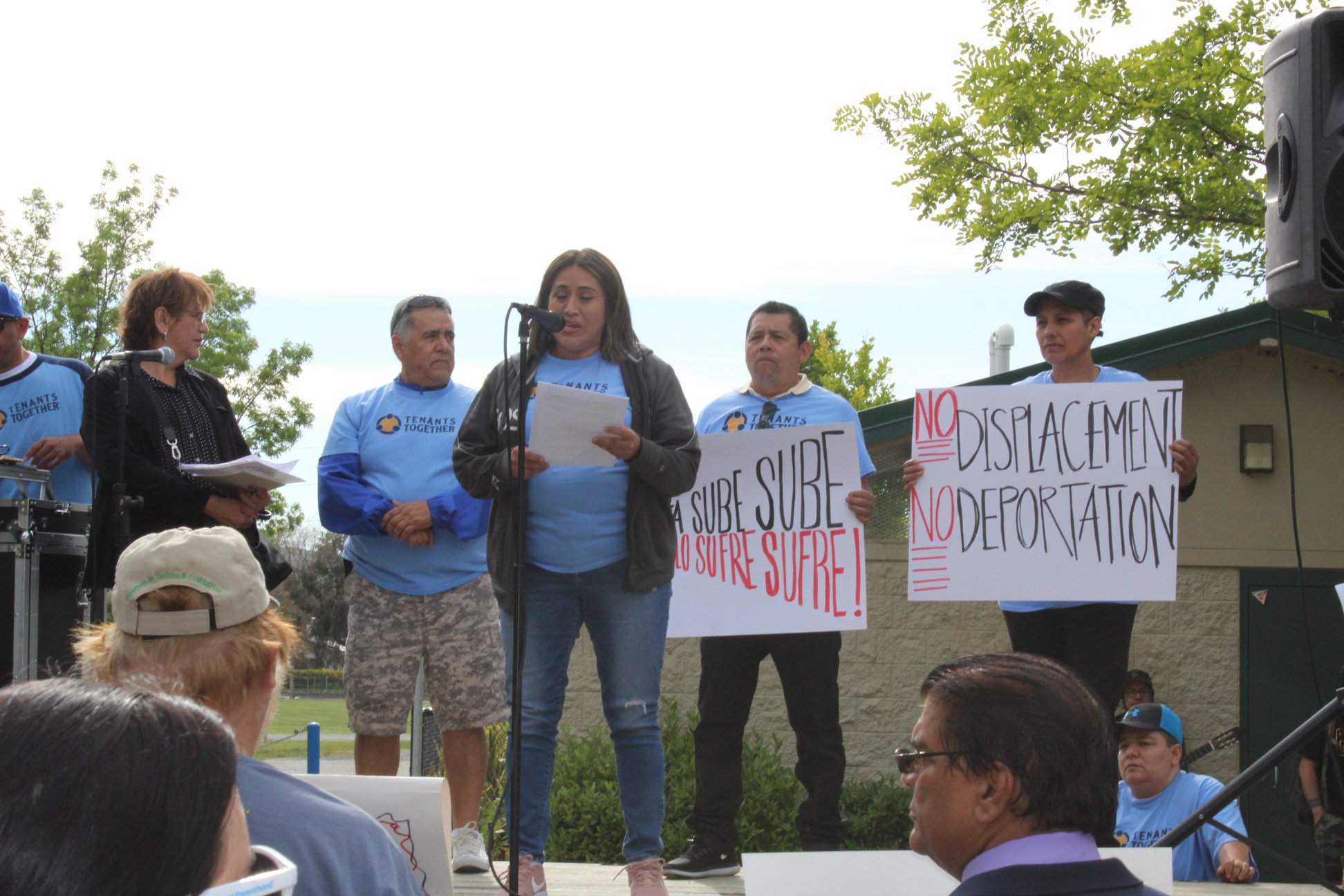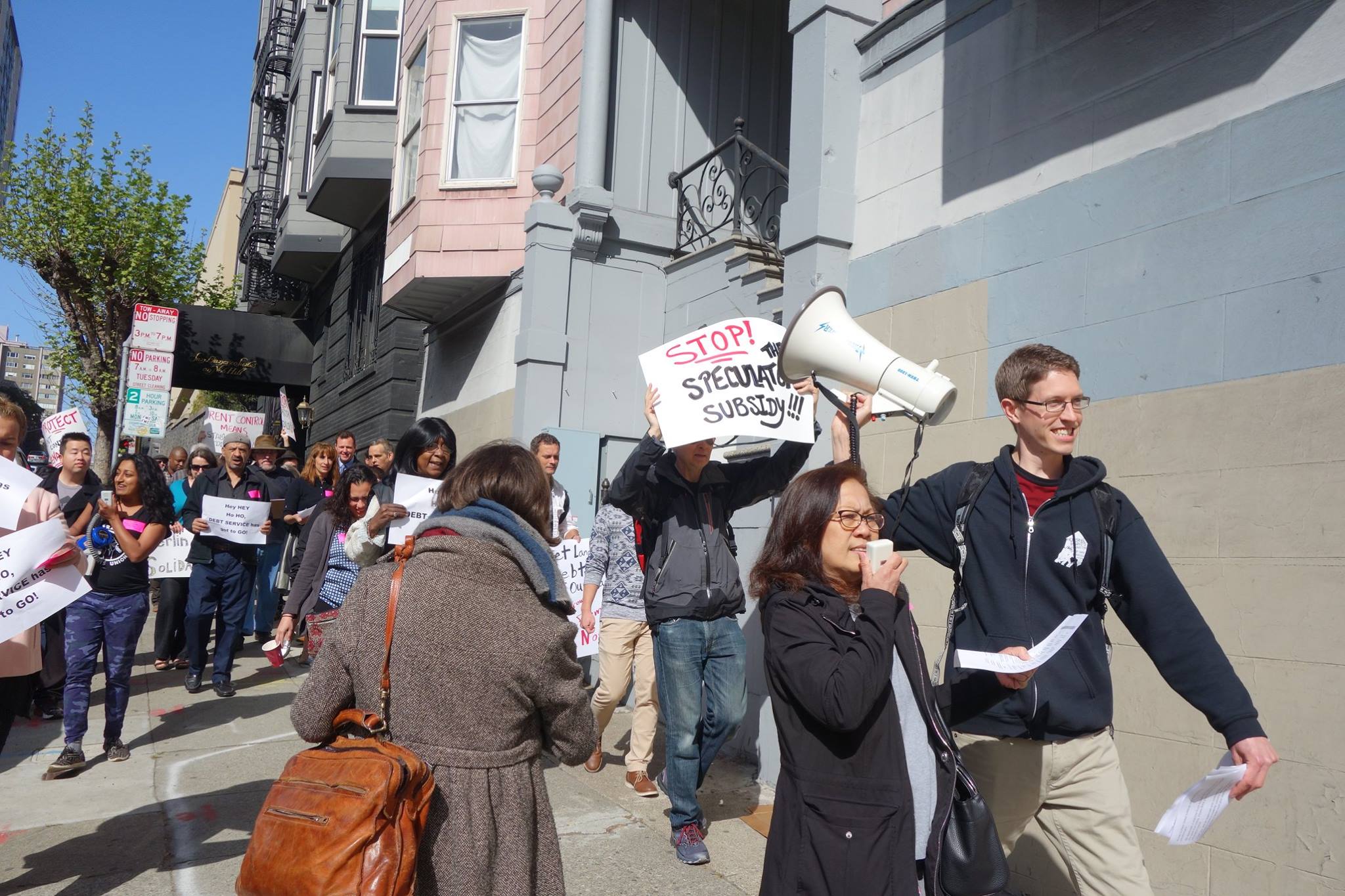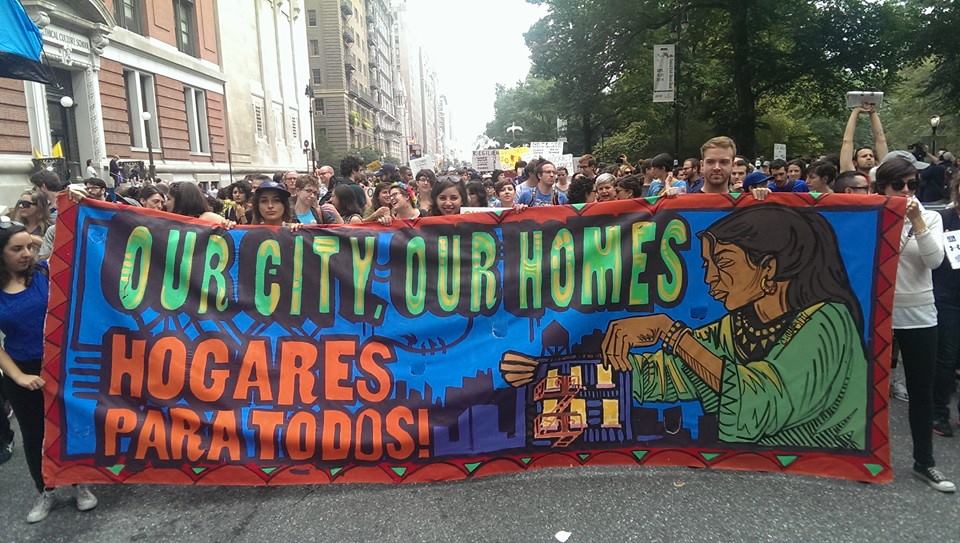What is a Tenants' Union?
Tenants' unions are building, neighborhood or city-based organizations made up of and led by renters themselves to fight for our collective interests and rights.
Building-based tenants unions are generally made up of tenants who live in the same building and/or have the same landlord. Neighborhood and city-based tenant unions are networks of tenants who often have similar issues and stand in solidarity with each other, but may live in different buildings or have different landlords.
Tenants Together/Homes For All tenant unions share a common vision and principles (see bottom), and unite with other tenant unions across our cities, states and country to build a movement of millions that is powerful enough to win rent control for all and tenant and community control of our housing and land.

(Organizing committee with the Concord Tenants Union)
Why form a Tenants Union? - Because you can win!
Everyone is talking about passing rent control and eviction protections, but where do you start? How do we build enough power to stay in our homes, communities and thrive?! We do this by organizing. We must organize because overcoming fear and isolation is impossible to do on our own. We organize because we seek to transform people's fear and isolation into dignity and solidarity both in your home, community and on a statewide level. Organizing isn’t just sending out an email or creating a social media page, although those will likely be steps that you take. Organizing is building real face-to-face relationships between you and your neighbors over time. The organization of tenant unions are the building blocks to our translocal, statewide, and international movement.
Currently tenant unions have fought off rent increases, evictions, and displacement in California and around the country without rent control and just cause eviction laws in place. A well organized tenant union can win rent control by being well organized and making bold demands up to collective ownership of the building by the tenants. Even if the politicians in your city don’t have the political will to do pass meaningful protections you can still organize with your neighbors and community to protect yourselves.
Current Renters Rights Movement Moment
California is in the worst housing crisis in recent memory. Tenants in cities across California are organizing tenants' unions in their buildings and communities and beginning to pass new rent control ordinances for the first time in over 30 years. Landlord lobbyists, corporate developers, and realtors oppose rent control and have a lot of power in the state, so passing rent control isn’t easy. Despite this challenge, we know we must fight to keep our homes.
Believe it or not, tenants are close to half of the population of the state of California, 17 million and counting. The California Apartment Association (the statewide landlord lobbyist group) claims 15,000 members statewide. They have money, but we have power in numbers, if we organize ourselves.
How did we get here/Roots of the Housing Crisis
The current crisis we are facing didn’t come out of nowhere: it is a result of intentional, racist and classist housing policy dating back to the New Deal era and even colonial times. For more on the roots of the housing crisis read this statement from TT's Rent Control Toolkit. These videos from KCET City Rising are also a good resource: https://www.kcet.org/shows/city-rising
Our Tenants Union Organizing Guide:
Values - Our model for organizing, coalition-building, and movement-building is rooted in our values. At Tenants Together, we believe that housing is a human right, not a commodity. We advance policy that is driven from tenant experience. To resist displacement, we must organize renters and other allied groups to make strong and bold demands of those in power. Organizing for tenants’ rights to us means organizing tenant unions and building associations, building tenant power for the long-term. If we are to win the most transformative policy, we must center our movements around those most affected: low-income people of color. We seek alignment with other movements fighting against structural oppression because tenants do not live single-issue lives, and the right to housing will only be won by building power with other movements. This includes, but is not limited to movements that build collective power and are rooted in racial, gender, economic, environmental, and disability justice; trans and queer liberation, and indigenous sovereignty.

(Tenants protesting their mega-landlord Veritas in San Francisco)
First 3 steps to building a Tenants' Union:
In each of our cities, our path to building organizations has been different, but we’ve learned from each other that there are certain steps that are important and helpful, regardless of the organizing model we choose to organize our communities. We are continually revising and updating them as we try them out and learn more. Many of the steps are not something we do and then move on from, they are steps we strive to weave into everything we do. We often do multiple steps at the same time, and sometimes revisit an earlier step.
Step 1: PLANT A SEED - FORM an Organizing Team and Join Tenants Together/Homes For All
Statewide movement - Join Tenants Together as a Member Organization or Partner https://www.tenantstogether.org/member-organizations-0
National Movement - Take Homes For All pledge https://homesforall.org/pledge/
Principles: Solidarity, Democracy
The Organizing Team is the seed, usually 3-4 people, mostly tenants or residents who are fed up and ready to do something together. With your organizing team talk about your vision of what you want to do together and how you want to do it. The more unified you can be, the stronger your seed will grow.
Step 2: WATER THE SEEDS - Start Reaching Out To Others In Your Community
Set a time to go canvassing (door to door knocking) to connect with other residents. This might be in your apartment complex,on your block or in your neighbors kitchen. It’s really important to share with others why you are organizing and listen to their concerns. A good rule of organizing is to spend two-thirds of your time listening.
TIP: Make sure to bring a form and keep track of the door you knocked, the response and what you talked about] name phone number/email, apartment number/address, and notes on what you talked abt. Sample at bottom of this page.
Step 3: GET TOGETHER: Hold your first building/complex/community Assembly
Note: many people call this a meeting instead of an assembly, but we call it an assembly because it encourages tenant empowerment, participation, and decision making. Calling it an assembly doesn’t mean there has to be large turnout! Sometimes smaller assemblies with a core group are better at first.
Principles: Solidarity, Mutual Care, Transformation
All of us have fear and shame that we must take head-on and let go of for us to move forward. We do this by coming together regularly, sharing our stories, listening deeply to each other and supporting each other and identifying our common suffering and ideas for solutions. This is a process and it takes time. Some things to consider when planning your first meeting agenda are:
-
PREPARATION: put an agenda together, identify a facilitator, let people know about the meeting in advance. Keep in mind these things: interpretation, food and childcare, and a location and time that works well for folks.
-
OPENING: this is where we make everyone feel welcomed and give them an opportunity to share about themselves; reground ourselves in our principles and purpose; choose a notetaker and timekeeper so meetings run smoothly and on time.
-
PARTICIPATION AND ROLES: we strive to create spaces and activities to allow and encourage everyone to participate, sometimes we break out in small groups or pair up for deeper discussion; provide opportunities for everyone to take different roles. For instance, residents can sign up to be “captains of their block or building,” they are in charge of disseminating and collecting information in their block.
-
MUTUAL AID & SUPPORT: it’s important to create space for us to share what’s coming up, provide support, and come up with plans to address the issues we are facing.
-
EDUCATION: we are often made to feel like the issues we face are individual or unique - it’s critical to always take time to understand the root causes of what causes displacement, eviction, rising rents and gentrification; we also take time to learn our history of housing struggles in our cities and beyond, and our what our rights are.
-
MAKING DECISIONS TOGETHER: often we identify common problems and make plans on how to solve them; we make key decisions democratically.
-
CLOSING: we make announcements, evaluate meeting, pass the hat and lift people’s spirits with a song or a chant. [BOX - sample chant]
-
FOLLOW THROUGH: It’s important that we carry out decisions we made and people follow through with their commitments; the notes are helpful to remind us what these were.
TIP: When you are first getting together to form a tenants' union, don’t get too caught up in technical details like by-laws or whether to incorporate as a 501-C3 or C4. Focus more on on good participation and and growing participation. If no one is part of the tenants' union then these details won’t matter much! Tenants Together has sample bylaws and other important training materials we can share with you once you begin to assemble.

Get Connected
Once you have followed the 3 steps below and/or held your first assembly in your building, complex or community, let’s check in! Discuss if you and your neighbors think our values are a good fit or want to think about starting to incorporate them into your work, and contact Tenants Together's Program Director, Deepa Varma, at deepa @ tenantstogether.org.
Statewide movement - Join Tenants Together as a Member Organization or Partner https://www.tenantstogether.org/member-organizations-0
National Movement - Take the Homes For All pledge https://homesforall.org/pledge/
Notes:
- Tenant: we define a tenant as those who are prospective tenants as well as those are intermittently homeless. While recognizing the need for broad housing justice, our work focusing on renters’ rights helps a core constituency, but does aid in the prevention of homelessness and the securing of housing.
- This guide was developed collaboratively by Tenants Together and our national partners in the Homes for All campaign after conducting a broad assessment of tenants' union organizing models. Check out this recent article on the work we and Homes for All are doing.
